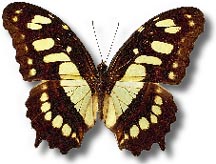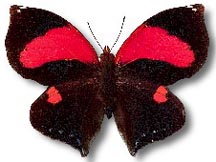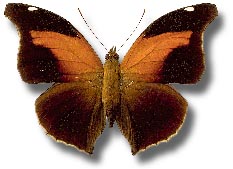As newlyweds, and with Peter tackling his first job as a
petroleum geologist, we found ourselves dumped into a company
house on an oilfield in Trinidad. The two-storey wooden bungalow
was situated on a narrow winding road that snaked through virgin
jungle, along the top of a ridge. The houses were placed a hundred
yards or so apart. While waiting for the office bus, we could
hardly help but notice the myriad butterflies flitting around
the flowers.
|

Soldat Martinique |
In the garden, the Soldat Martinique or Milkweed butterfly, was quite common. Their caterpillars feed off the milkweed which contains strong poisons and the butterflies themselves become poisonous to birds or lizards who try to eat them. Thus they feel perfectly safe flying slowly from flower to flower, out in the open. |
|
Another butterfly that flies sedately around secure in the knowledge that no bird wants to eat it is the tiger. Yellow and black as with the wasp, are Mother Nature's warning signals, and they say 'eat me at your peril'. But there are lots of other species that mimic the tiger's colours to secure protection. The female of one sweet oil is painted in these colours, but the male has to fend for himself because if there are too many mimics the protection fails! |
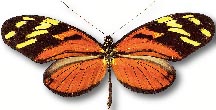 Tiger Mechanitis veritabilis |
|
Gonepteryx maerula |
The Sweet Oil, as its name implies, is very tasty to eat if you are a bird and so it flies very fast and erratically, thereby obtaining a certain measure of safety from its predators. Once landed on a branch, with wings folded, it almost disappears because its underside blends so well with the surrounding foliage. With this in mind, some butterflies have developed very distinct markings which suit their preferred habitat. Thus we get the Bamboo Page which spends all its time flitting around the bamboo groves. |
Victorina steneles |
One of the best known tropical butterflies is the Blue Emperor. Brooches and ornamental pictures have been produced using its iridescent blue wings. This belongs to the second group of butterflies because it feeds on fruit and sap from trees. It is hard to imagine but this beautiful creature also relishes newly dropped animal dung!
|
They are very curious butterflies and we discovered that if we placed a piece of blue paper in their flightpath, or if Peter wore a blue shirt, they would always divert from their line of flight in order to investigate. Betty took to making a quiche or savoury flan to take for our lunch, sandwiches being too dry to eat in such heat. To make them even 'moister' and help quench our thirst, she would cover them with finely chopped spinach mixed in a white sauce. We soon discovered that the Blue Emperor was particularly partial to this delicacy and dozens would scramble all over our hands, fighting to get their long probosces into our slice of pie. In fact, we had to literally push them to one side before taking a bite ourselves! |
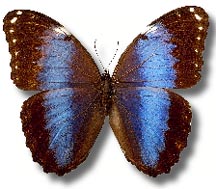
Morpho Achilles Insularis |
|
Siderone marthesia |
The Cow Shoemaker and the Grape Shoemaker are also fruit
eaters. The underside of their wings mimic a dead leaf giving
them perfect disguise as they sit amongst the fallen fruit under
the tree.
|
Aganisthos odius |

